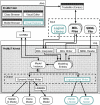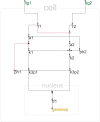Visual setup of logical models of signaling and regulatory networks with ProMoT
- PMID: 17109765
- PMCID: PMC1665465
- DOI: 10.1186/1471-2105-7-506
Visual setup of logical models of signaling and regulatory networks with ProMoT
Abstract
Background: The analysis of biochemical networks using a logical (Boolean) description is an important approach in Systems Biology. Recently, new methods have been proposed to analyze large signaling and regulatory networks using this formalism. Even though there is a large number of tools to set up models describing biological networks using a biochemical (kinetic) formalism, however, they do not support logical models.
Results: Herein we present a flexible framework for setting up large logical models in a visual manner with the software tool ProMoT. An easily extendible library, ProMoT's inherent modularity and object-oriented concept as well as adaptive visualization techniques provide a versatile environment. Both the graphical and the textual description of the logical model can be exported to different formats.
Conclusion: New features of ProMoT facilitate an efficient set-up of large Boolean models of biochemical interaction networks. The modeling environment is flexible; it can easily be adapted to specific requirements, and new extensions can be introduced. ProMoT is freely available from http://www.mpi-magdeburg.mpg.de/projects/promot/.
Figures






Similar articles
-
PROMOT: modular modeling for systems biology.Bioinformatics. 2009 Mar 1;25(5):687-9. doi: 10.1093/bioinformatics/btp029. Epub 2009 Jan 15. Bioinformatics. 2009. PMID: 19147665 Free PMC article.
-
Modular modeling of cellular systems with ProMoT/Diva.Bioinformatics. 2003 Jun 12;19(9):1169-76. doi: 10.1093/bioinformatics/btg128. Bioinformatics. 2003. PMID: 12801880
-
Automatic decomposition of kinetic models of signaling networks minimizing the retroactivity among modules.Bioinformatics. 2008 Aug 15;24(16):i213-9. doi: 10.1093/bioinformatics/btn289. Bioinformatics. 2008. PMID: 18689828
-
Designing and encoding models for synthetic biology.J R Soc Interface. 2009 Aug 6;6 Suppl 4(Suppl 4):S405-17. doi: 10.1098/rsif.2009.0035.focus. Epub 2009 Apr 1. J R Soc Interface. 2009. PMID: 19364720 Free PMC article. Review.
-
Evolving a lingua franca and associated software infrastructure for computational systems biology: the Systems Biology Markup Language (SBML) project.Syst Biol (Stevenage). 2004 Jun;1(1):41-53. doi: 10.1049/sb:20045008. Syst Biol (Stevenage). 2004. PMID: 17052114 Review.
Cited by
-
Systems biology of Ewing sarcoma: a network model of EWS-FLI1 effect on proliferation and apoptosis.Nucleic Acids Res. 2013 Oct;41(19):8853-71. doi: 10.1093/nar/gkt678. Epub 2013 Aug 8. Nucleic Acids Res. 2013. PMID: 23935076 Free PMC article.
-
PROMOT: modular modeling for systems biology.Bioinformatics. 2009 Mar 1;25(5):687-9. doi: 10.1093/bioinformatics/btp029. Epub 2009 Jan 15. Bioinformatics. 2009. PMID: 19147665 Free PMC article.
-
Comparing signaling networks between normal and transformed hepatocytes using discrete logical models.Cancer Res. 2011 Aug 15;71(16):5400-11. doi: 10.1158/0008-5472.CAN-10-4453. Epub 2011 Jul 8. Cancer Res. 2011. PMID: 21742771 Free PMC article.
-
The Process-Interaction-Model: a common representation of rule-based and logical models allows studying signal transduction on different levels of detail.BMC Bioinformatics. 2012 Sep 28;13:251. doi: 10.1186/1471-2105-13-251. BMC Bioinformatics. 2012. PMID: 23020215 Free PMC article.
-
Logic-based models for the analysis of cell signaling networks.Biochemistry. 2010 Apr 20;49(15):3216-24. doi: 10.1021/bi902202q. Biochemistry. 2010. PMID: 20225868 Free PMC article. Review.
References
-
- Thomas R, D'Ari R. Biological Feedback. Boca Raton, CRC Press; 1990.
Publication types
MeSH terms
LinkOut - more resources
Full Text Sources

